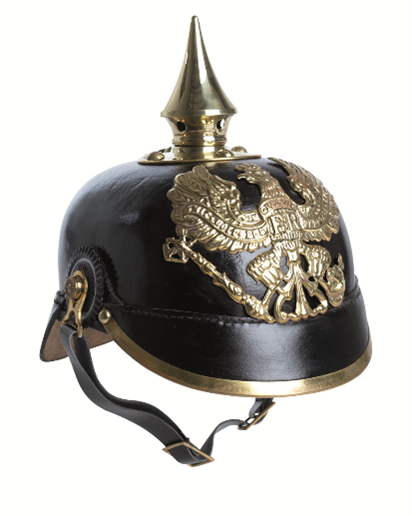German Picklehaube

Country of Origin: Germany
Year: ca. 1900-1914
Materials: Lacquer, leather, and brass
Few relics of military history are as striking as the German Pickelhaube. The black lacquered leather helmet with its intricately detailed gilded brass helmet plate and tall spike was intended to create the image of highly aggressive military force. The helmet was originally designed by the Prussian King, Friedrich Wilhelm, in 1842 and was a standard piece of uniform from that period onwards. There are three main leather parts of the helmet: a basic shell with a front and rear visor that are sewn on. The shell was formed by pressing a piece of steamed leather through a large mold. The helmet was then covered in many layers of black lacquer until it could be polished to a bright finish. The helmet had two brass reinforcing trim pieces at the front visor and a brass spine at the rear of the helmet. The front of the helmet is covered with a large, gilded brass helmet plate called a “wappen” which denoted the specific regiment of the wearer. The wappen on the piece exhibited here has the motto “MIT GOTT FÜR KOENIG UND VATERLAND” (With God for King and Fatherland) above the “FR” cypher. The royal eagle motif wearing a crown, holding items of ruler ship in its talons staff has fully spread wings is based on the Prussian Royal standard, though was absorbed into German Iconography in the late nineteenth century.
The artifact on display is likely dated prior to 1915, based on the extravagant materials used and overall design. In 1915, the expensive brass and German silver fittings on all issued helmets were changed to steel to free up brass and silver needed for the war effort. In an effort to make the wearer less obvious and visible, the spike was then made removable. Helmets from this period tend to reflect the war time economy and are usually made from a much thinner leather than older helmets. This piece was collected by Edward Montgomery Harris who served as part of the Canadian Expeditionary Forces during World War I.